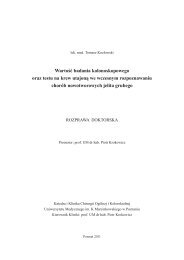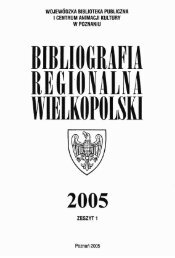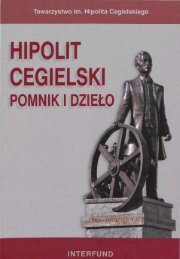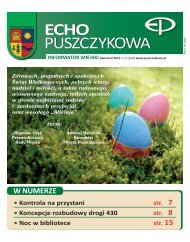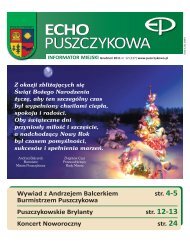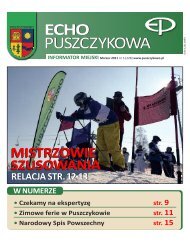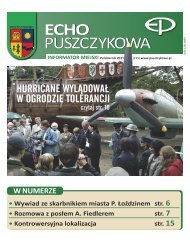MILITARY PHARMACY AND MEDICINE
MILITARY PHARMACY AND MEDICINE
MILITARY PHARMACY AND MEDICINE
You also want an ePaper? Increase the reach of your titles
YUMPU automatically turns print PDFs into web optimized ePapers that Google loves.
© Military Pharmacy and Medicine • 2012 • 4 • 34 – 50particularly to reduce or relieve pain and fever, aswell as to improve certain less precisely defined ailmentsthat reduce the comfort and quality of life.The progenitor of the NSAID family isacetylsalicylic acid — aspirin, a drug with ahistory of more than 100 years and enormousworldwide popularity. Aspirin was introducedinto the drug market in 1899 and hasbeen extensively used ever since, althoughmany other analgesic, antipyretic and antiinflammatorydrugs have also became availablein that period. The word aspirin contains thestem spir, referring to the Latin term Spireaulmaria, i.e. meadowsweet (modern name isFilipendula ulmaria) — a plant from which theglycoside salicin, characterized by analgesicactivity, was initially obtained. Salicin generatesanalgesic salicylic acid which is transformed byacetylation into acetylsalicylic acid (ASA), i.e.aspirin. The first letter of the word aspirin, i.e.the letter a (preceding the stem, i.e. spir) stoodfor acetylation, while the suffix in was commonlyadded to the drug names at that time.Aspirin’s mechanism of action was elucidatedin early 1970s, when Sir John R. Vane — anEnglish pharmacologist and physician, togetherwhith two Swedish researchers, SuneK. Bergstrom, Bengt I. Samuelsson — discovereda cyclooxygenase-dependent pathway oftransformations of arachidonic acid into prostaglandins(for which they were later awardedthe Nobel Prize in physiology and medicine in1982) [1]. The researchers demonstrated that aspirincauses acetylation of cyclooxygenase andinhibits the synthesis of prostaglandins — endogenousmediators of inflammatory reactions,pain sensation and pathologically elevatedbody temperature. These observations turnedout to have far reaching consequences, as theybecame the point of departure for the researchof other compounds that would inhibit cyclooxygenaseactivity, with hopes that at leastsome of these compounds would become moreefficient and safer than salicylates (includingaspirin), expressing mainly anti-inflammatoryand analgesic activity. This initiated the era ofNSAIDs — ones of the most common drugs intoday’s medical therapy, used mainly in the reliefof pains of various origins and diverse inflammatoryconditions.Review articleThe mechanism of action of NSAIDsAll NSAIDs exert their activity in the processof conversion of arachidonic acid (AA) intoprostaglandin H–PGH 2[2]. This step is catalyzedby prostaglandin H synthase (PGHS), having adual enzymatic activity of cyclooxygenase andperoxidase. The AA → PGH 2conversion consistsof a sequence of two reactions: first, cyclizationof AA into an unstable 15-hydroxyperoxide(PGG 2) followed by double oxidation in positions9-11 by means of the cyclooxygenase componentand next, reduction of the 15-hydroxyperoxidegroup in PGG 2molecule, leading to anequally unstable PGH 2; this step is achieved bymeans of the peroxidase activity of PGHS [1] .Prostaglandin H 2is a substrate for specificsyntha-ses, tissue-dependent isomerases that catalyzeits transformations into various endogenousregulators, such as prostaglandins ofthe D (PGD 2), E (PGE 2), and F (PGF 2) series,prostacyclin (PGI 2) and thromboxanes (TXA 2and TBX 2) — all products characterized by diversebiological activities, with some of them havingpro-inflammatory action (Fig. 1).One should keep in mind that arachidonic acid(AA) is a substrate for many other important,biologically active molecules, to mention only thepro-inflammatory leukotrienes (resulting from AAmolecules undergoing transformation by the activityof lipoxygenase [LOX]) or anti-inflammatory[1] Conversion of arachidonic acid (AA) into prostaglandin H 2 (PGH 2 ) consists oftwo reactions: the first reaction involves an oxygen molecule being incorporatedinto the AA molecule and the resultant structure undergoing cyclization into anunstable prostaglandin G 2 (PGG 2 ), while the other reaction involves reductionof PGG 2 to its 15-hydroxy analog, i.e. PGH 2 . These reactions are catalyzed byprostaglandin H synthase — a bifunctional enzyme exerting both cyclooxygenaseand peroxidase activities. Some textbooks suggest that the cyclooxygenation isachieved by the activity of cyclooxygenase (COX) while peroxidation is achievedby hydroperoxidase (HPOX); however, PGHS is most commonly identified asCOX. Cyclooxygenase was described in 1976, and its amino acid sequence wasdetermined 12 years later. The spatial structure of COX was elucidated as late as inyears 1994–1996 — by that time, it was already known that two isoforms of theenzyme, COX-1 and COX-2, existed, the latter one being inducible by inflammatorystimuli (including pro-inflammatory cytokines such as IL-1β or TNFα). Followingcell activation, COX-2 gene activity reaches its peak value within a dozen or sominutes, and is later reduced to non-determinable levels within one hour. Theactivity of COX-2 increases about 1 hour after the inflammatory stimulus and ismaintained at a high level for several hours after that. The increased activity ofCOX-2 leads to rapid formation of prostaglandins within the pericellular spaceand development of an inflammatory reaction. The main difference in the spatialstructure of the two isoforms COX-1 and COX-2 is that the COX-2 molecule has awider cyclooxygenase activity channel and features a side pocket associated withthe presence of valine instead of isoleucine at position 523 of the COX-2 molecule.Molecules of selective COX-2 antagonists blocking the channels containing theactive sites of the enzyme anchor their side chains in said pocket.34 http://military.isl-journals.com



